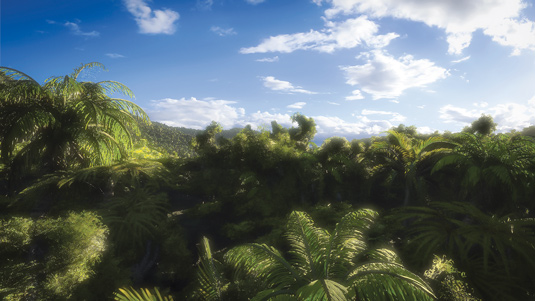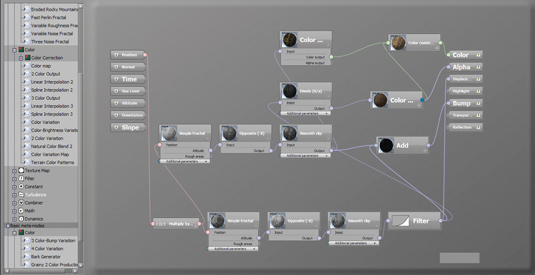Why you can trust Creative Bloq

Things might just be heating up in the environments software world. With the release of Terragen 3 last year finally we had a contender to the king of digital environment software, Vue. And now, seemingly in response to this, e-on software has pushed some features that can be enjoyed by all Vue users.
The most standout of all the changes to Vue is the new Photometric Spectral Atmosphere Model. This, according to e-on's website is a new rendering process that uses "real world, physical simulation of sun and atmosphere lighting intensities". I've spent a while with it, testing different options, and it really shines in some areas but it does take a lot of control away from the user.
So, as with any major change in rendering, expect to have to recreate your scenes and modify materials if you're going to test it out on old work. The new system is definitely a step forward though, as it allows for more photographic exposure. If you've taken a photo in a dimly lit room with the sun shining outside, you'll notice that either the room is darker than it should be or your image is blown out in the bright areas. Photographers try to avoid this effect, but it is sought after in the digital world.
Improved integration
Other than this major change there is a plethora of smaller, but welcome, additions. We start with the integration improvements, something that will appeal to studios with larger pipelines. It is now even easier to import and export .fbx files to Nuke, and render elements are exported in OpenEXR 2.0 format at 32-bit (with passes available in 32- or 16-bit).
It's also really good to see the addition of a World Point Position (or XYZ) Pass. This is great for compositing in Nuke, although I haven't had time to test it out for myself yet. These additions are giving Vue a better edge in larger pipelines. Flexibility is key here and being able to move elements to Nuke for relighting and other effects is going to be a very welcome inclusion for many.
E-on remains dedicated to innovating new features to keep Vue at the forefront of environment creation. The last few releases have added some subtle functions that allow ecosystem instances to be better controlled. Vue 2014 brings more of those additions.
A 'natural grain' colour node has been added, described as a no-fuss option for creating quick results. Unfortunately it's not quite what it first suggests. In 3D we want to recreate the 'imperfections' of nature - and that is where I saw 'natural grain' fitting in, to break up the monotony of a material you have already created.
However, when the option is selected, I find that it simply removes all colour elements of the material and creates a two-tone grey noise. Upon further investigation into the Function Editor - which is absolutely amazing now - we see that the previous colour nodes are left but just disconnected.

This is okay, as we can hook the previous colour back into this natural grain node, but it still doesn't produce the desired effect. Of course there's only so much you can expect from a 'one click wonder', I just would have expected it to be implemented in a way that was less destructive to existing materials.
Dynamic ecosystems
If you've ever tried to render a field of rocks, or physical moss-geometry on a rock, you'll appreciate just how long some of these scenes can take. Some can even be impossible if the machine you're rendering on doesn't have a lot of memory.
While using dynamic ecosystems helps with the memory problem, the issue can still remain and with Vue 2014 e-on has reportedly improved
the rendering algorithms to help with management of these large instance ecosystems.

How much these influence your own render times will depend on how your scene is set up and your individual workstations. One thing I am still waiting for is a fix to the dreaded 'last square' render delay. When rendering these kinds of ecosystems especially, there are often render segments that, once all else is done, can take hours longer and delay the image considerably.
What needs to be done here is a division of the remaining labour so that all idle memory is put to use. My main work machine is equipped with 24 cores, and it seems a total waste to have 23 sitting idle while a single core spends an irrational length of time on the final square.
The world of environment software was ramped up with the release of Terragen 3, so it's unsurprising to see e-on pulling out the stops and upping the efficiency of some functions. This update has a good, well-rounded list of updates and new features that will appeal to all users.
Words: Conrad Allen
Conrad Allen is a freelance artist with over five years' experience with Vue. This article originally appeared in 3D World issue 181 - on sale now!

Thank you for reading 5 articles this month* Join now for unlimited access
Enjoy your first month for just £1 / $1 / €1
*Read 5 free articles per month without a subscription

Join now for unlimited access
Try first month for just £1 / $1 / €1
The Creative Bloq team is made up of a group of design fans, and has changed and evolved since Creative Bloq began back in 2012. The current website team consists of eight full-time members of staff: Editor Georgia Coggan, Deputy Editor Rosie Hilder, Ecommerce Editor Beren Neale, Senior News Editor Daniel Piper, Editor, Digital Art and 3D Ian Dean, Tech Reviews Editor Erlingur Einarsson, Ecommerce Writer Beth Nicholls and Staff Writer Natalie Fear, as well as a roster of freelancers from around the world. The ImagineFX magazine team also pitch in, ensuring that content from leading digital art publication ImagineFX is represented on Creative Bloq.
